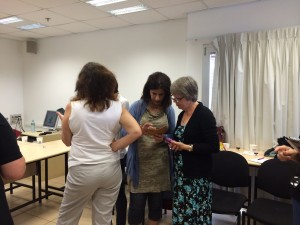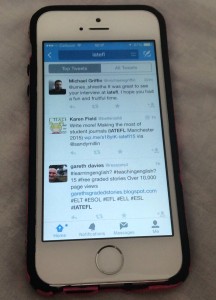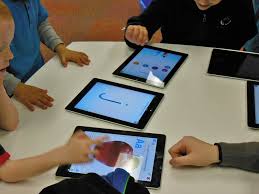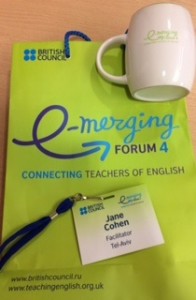- Use relevant hashtags so that others can see your tweets, i.e. #IATEFL #ELT #edtech #eltchat
- Look for the speaker’s Twitter account in advance of their presentation in order to include them in your tweets
- RT – retweet tweets that you like, identify with and want to share
- Thank others for tweeting from your sessions, and for retweeting your tweets
- The conference continues well after it is over with the blog summaries being posted on twitter
- As it is s so affirming when someone tweets from your sessions, why not tweet things your students say that will resonate with the rest of the class?
- It is a great way to check students’ understanding of a lesson by asking them to tweet what they now know as a consequence of the lesson
Digitally competent or not
A fox aspiring to be an OWL -A case study, LAMSIG IATEFL 2015
As a DOS / managing director of a language school I deal with challenges and conflicts on a daily basis, which can lead to stress. I deal with stress by running three or four times a week. Just lately on my runs I have encountered a fox that comes out at dawn and dusk, to look for food. I noticed that we have a number of things in common. We run at the same times of day, we are usually alone and we are looking for opportunities (to eat, in the case of the fox, to get fitter and think clearer, in my case).
At the end of the LAMSIG (leadership and management PCE) which focused on case studies I am left pondering what kind of a manager am I, as portrayed by Thomas and Kilmann,1977? I know I’m not the competitive shark or the accommodating teddy bear, but do identify with the turtle who likes to avoid difficult situations. However I probably am more similar to the compromising fox than I should be as a manager. Now that I have had the time to reflect, actively listen and learn from colleagues from all over the globe I will aspire to become the wise owl, who is able to collaborate more successfully in difficult situations.
So like the fox in my neighbourhood my job can be quite lonely, yet there are opportunities out there for collaboration. I don’t need to fend for myself but I do need to manage, as that is what I am paid for. So the next time a conflict arises I will ’embrace the conflict’, say yes and activate my negotiation skills. I will strive to be an owl by separating the people (their emotions, values and perceptions) from the problem. I will focus on the reasons for the conflict and explore all the options for the benefit of the organisation, and hopefully all involved.
Although not yet an owl, I do feel a little wiser following today’s fantastic LAMSIG PCE.
The Red Rabbit generates the Tower of Babel
Red Rabbit from Egmont Mayer on Vimeo.
The room is set up with chairs in clusters of 4, with some facing the screen and some facing away from the screen. The guest lecturer is standing in the room as the Dialog language teachers start entering the room. Within seconds they have started moving the chairs into rows and there is little that can be done to stop them. They are expecting a lecture and are deaf to the pleas to leave the chairs as they are. Learning point – tell participants before they enter the room that they are not to move the seats, as they have been arranged in a specific formation, for a reason.
Leo Selivan, of Leoxicon, is ready to start but is struggling to be heard over the noise of 55 teachers chattering excitedly in 10 languages. Suddenly the room is silent and Leo has their attention. Leo opens the session with a discussion around the use of videos in the classroom, with a particular focus on the possibilities of generating language from silent movies. The teachers are interested but not yet convinced. Leo asks the teachers to organise themselves into language groups of up to four per group, with one person per group facing the screen and the others with their backs to the screen. The task is for the ‘watchers’ to describe what they see on the screen, while the other members of the group listen carefully and try to understand the plot unfolding, on the screen that they can’t see. After 2:46 minutes Leo stops the movie and asks the teachers to swap places, the ‘watchers’ are now the ‘listeners’, and the ‘ listeners’ are now the ‘watchers’. The narrative continues…
As the teachers listened, described, questioned, gestured and laughed aloud, I wondered around the room enraptured by the cacophony of languages being heard. This was organised chaos, and it was exciting. The descriptions of the ‘Red Rabbit’ that I could identify in so many languages, including Spanish, German, Hebrew, Arabic, Russian, Italian, French and English was akin to what I imagine it might be like at the United Nations. As I looked across the room I was clearly aware that the teachers were engaged and on task. The scene created was reminiscent of the story of the Tower of Babel, though this time the tower was the Red Rabbit, and the goal was to generate language rather than reach the heavens.
Four months later and the activity has been tried in a number of Dialog classes in multiple languages. An English teacher reported that one student in a pre-intermediate class was so excited by the experience, and refused to let his language limit his narrative, that as he gestured wildly he shouted; “Oh it is a big, big rabbit. It is a Rabbit Rabbit!”(Doubling a word in Hebrew, is a common way of emphasising something.) A Spanish teacher used the activity with her pre-intermediate class, and stated that though her students really enjoyed the activity they were frustrated by their limited vocabulary, she told me that she now realises that she should have pre-taught the requisite vocabulary. Reflection par excellence!
As English teachers you’re probably not trying to create the Tower of Babel but I strongly suggest using this activity, and the others Leo shares in his blog, “Not a word was spoken (but many were learned), with your learners for a fun, interactive and challenging learning experience.
Teaching with Technology – First Task = Create your own online course!
After the first online synchronous lesson of ‘Teaching with Technolgoy‘ with Dr Nellie Deutsch on Tuesday 6 January, I was all fired up to really learn about teaching online. Due to terrible weather and an unusually slow internet connection that night Imissed parts of the audio and as a consequence didn’t realise that the first task would be to set up a Blog or Wiki (luckily I already have both), answer some questions on one of those platforms and then set up my own online course. The first task I can do without too much problem. However I am concerned about my ability to set up a useful online course without any real planning. However, I do have a need for such a course as I want to provide online teacher training to my teachers at Dialog.
Task 1: Answer the following questions:
What does teaching with technology mean to you?
Teaching with Technology means using technology to support and enhance the learning aims that I have set my students. Technology today is at our fingertips, in our pockets and in most classrooms. As a language teacher in 2015 the free resources at my an my students’ disposal our limitless. Why wouldn’t I use them? With apps and websites to enrich our lessons and engage our students, with Wikis and Blogs, and collaborative noticeboards such as Linoit and Scrabblr, and vocabulary learning tools such as Quizlet, the opportunities are truly endless and even overwhelming. However as a teacher / teacher trainer it is my role to choose the tools that enhance the learning goals. I need to ask myself reflective questions such as, “Am I showing this Youtube video because it relates to the theme, promotes listening comprehension and expands the students’ vocabulary, or am I using it because it is cute, the students will love it and the school will be happy that I have integrated technology into my lesson?”
So for me technology is a must but it must be simple, I must have a back up plan for when it doesn’t work and it must, most of importantly of all support the learning aims not drive the class.
What do you expect students to learn from the course?
‘EFL Teacher Training for Language Teachers of Adults’ – this course will be a pilot for a language teacher training course that I want to create for ‘Dialog’ language teachers to access online at any time. We have new teachers joining us on a weekly basis who come with all different teaching backgrounds. This course will provide an introduction to communicative language teaching, with a focus on the integration of Learning Technologies into the learner-centred classroom.
What skills and knowledge do you want them to acquire by the end of the course?
Students / participants will have a clear understanding of what the communicative approach to language teaching is and how it relates to adults in particular. Setting the stage, and the importance of making an impact from the very first lesson; the use of L1 (native language) in the classroom; differentiated instruction; lesson planning; 21 Century teaching skills; the role of homework; teaching grammar and vocabulary; error correction versus fluency, evaluating and assessing content , and lastly evaluating and assessing student levels and progress.
What teaching strategies (lecture, discussion, group work, case studies, etc.) will best help students achieve these goals?
The course will combine synchronous lessons supported with PowerPoint presentations, reading assignments, discussions and tasks such as creating a model lesson plan.
Learning from a mentor
In my lost post I mentioned how frustrated I was with my blog and that I was feeling digitally incompetent as a result. In true digital style I tweeted for help and two ELT colleagues, Julie Bytheway and Naomi Epstein, immediately swooped in to help. Naomi, a local ELT leader, invited me over tonight for a hands on mentoring session. This post is one of the results. I can sleep a little easier and now focus more on content than on layout. I feel so much more digitally competent now.
Struggling to add share buttons on my edublog
I have just spent about 5 hours trying to update my blog, when I thought it would be just a matter of paying to become a pro-user and then I would be able to add a few more pages and start adding some, share buttons (twitter, facebook etc) and ‘fascinating’ content. However, I have not managed to add the share buttons despite using the edublogs help videos, as well as other online videos. So I still have no new content, and I feel frustrated and digitally incompetent.
Aaaargh!!!
Are my conversation classes more than recitation?

In my new job as Managing Director of Dialog, The Open University Israel, I am keen to ascertain what is the conversation based approach being employed in our school. Is it the communicative approach or a mixture of approaches (eclectic) or is it more akin to PPP?
Having observed a number of classes and teachers it is too early for me to say, however what I can say is that I need to refresh my ELT and LOTE pedagogical knowledge. This is what led me to reading Phillip Chappell’s “Engaging learners: conversation-or dialogic-driven pedagogy? (ELT Journal Volume 68/1 January 2014, pp.1-11) The article looked at the conversation that most often takes place in language lessons based upon Dogme principles. According to Chappell the most predominant form of conversation is recitation script which is most akin to classroom talk rather than the desired natural conversation that teachers strive for. However Chappell purports that if teachers record a few lessons and transcribe the conversation taking place, they can reflect upon whether the language is more ‘classroom talk’ or ‘dialogic inquiry’ – “those language acts whose purpose is to engage another in one’s attempt to understand” (Lindfors, J.W 1999).
Although I myself have always thought my lessons very much reflected the Inquiry dialogue approach, after reading Chappell’s analysis of a number of ‘typical’ language interactions in the ELT classroom, I now believe that too many of the conversations taking place in my classes are more recitative than I would care to admit. Will I find the same in the classes that I am going to observe, and if I do what am I going to do about it?
e-merging forum 4 – Moscow 2014 – ‘Learning Technologies Track’
I recently returned from the e-merging forum 4 in Moscow where I had the opportunity to facilitate the Learning Technologies track together with Elena Kazachkova and Nicky Hockly. This was a wonderful professional development opportunity for me as I was able to learn from the local presenters as well as from Nicky, who is both a great presenter and an advocate for incorporating LT into the ELT classroom along with the active teaching of ‘Digital Literacies’. In each of the presentations, in the LT track, the themes of engagement, motivation and learner autonomy as enhancing learning outcomes came through very clearly.
In Elena Peresada’s talk: ‘How to Gamify your English class’ we were shown how all students can be motivated to achieve ‘Personal Bests’ through the use of a game design approach to teaching. Elena explained that XP points (experience points)’ a leaderboard and healthy competition are criteria for this approach. It was interesting to see that Elena has flipped the concept of Gamification by applying Online Gamification rules and techniques to traditional learning in her classroom without any computers, to increase student motivation and self-autonomy.
Anna Avramenko’s talk: New educational standards, Mobile competence of students and teachers in Russia, referred to the mobile competencies of both teachers and students. Anna highlighted the difference between ICT and MT( mobile technology), and said that many teachers do not yet feel comfortable with MT, despite the fact that this is their students preferred way of learning. Anna explained that with the use of MALA (mobile assisted language assessment) teachers and institutions are able to track progress immediately and effectively. Anna also spoke of PELE, a peer assessment system, and said that students are keen to use online polls in class, as polls provide instant feedback, which students find both motivating and engaging.
Vera Bobkova led an interactive workshop: ‘Time savers for Busy Teachers’ which gave the audience an opportunity to see that engaging activities can be prepared quickly by using online tools such as a dictionary apps, crossword creators, story cubes and the ‘Big Wheel’. Vera’s message was, get the students to create the games and tasks wherever possible, because they love it, and their learning is enhanced; and the best of all is that it saves time for busy teachers.
Anna Loseva shared with the audience her use of Social media as a learning opportunity for students. In her talk: ‘International student collaboration on Facebook: what it is and what it isn’t,” Anna explained how she had responded to a single student’s request for authentic language practice. Anna set up a FB group in 2011 for 17-23 year olds, and asked teachers to join and bring their students to the closed group. Since then the group has grown to over 500 members from 23 countries. Anna shared the challenges and the successes, and encouraged us all to try this medium for engaging learners by providing authentic language opportunities.
Little pigeons can carry great messages or using online post its in ELT, Anastasia Fetisova shared her ‘fetish’ for post it notes. Anastasia started off by showing us multiple ways of using physical post its for ice breakers, for spelling words, for writing poems and for labeling the body parts of some willing volunteers in the audience. Anastasia then went on to share with us a multitude of digital tools that offer numerous creative ways of using post its to engage, motivate and stretch our learners, for example, www.scrumblr.ca; www.primarywall.com; www.telescopictext.com; www.telescopictext.org (Creating and expanding sentences); www.noteapp.com
In her talk: Using Wikis to create collaborative teacher student sites, Alexandra Smirnova spoke of the Wiki as a collaborative storeroom, as a tool for organization and collaboration, where everybody can be involved from the teacher, the students to the parents. Alexandra explained that all digital tasks can be stored in the one place on a Wiki, from Vokis, to e-books, to podcasts and videos, which is really useful for everyone to quickly access each other’s work. Lastly, Alexandra showed us how we can use hypertext to create web quests.
The Learning Technologies plenary: Digital Literacies, was delivered by Nicky Hockly, who so skillfully convinced us all of the existence of the endangered species; The Pacific North West Tree Octopus, which surprisingly enough does not exist, in order to demonstrate how our students tend to assume anything that is published on the web must be authentic. Nicky showed us the importance of evaluating websites and how to do it and emphasized four areas that need to be focused on: Information; Language; Connections and Redesign. After she presented the theoretical background to integrating Digital Literacies in the ELT classrooms, Hockly share some great activities with the audience using Remix and Literal Videos. Check out: goo.gl/Ut7Yru and youtu.be/MahTKZDHXaA. Catch an interview with Nicky Hockly after she gave her plenary for more information.
For my video summary of the entire conference you can catch me on the TeachingEnglish website. Now I can’t wait for e-merging forum 5.
Continuing Professional Development is ….
Please complete the sententence:
I used to think CPD is … but now I think CPD is





